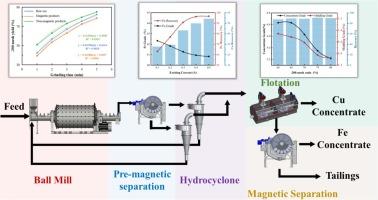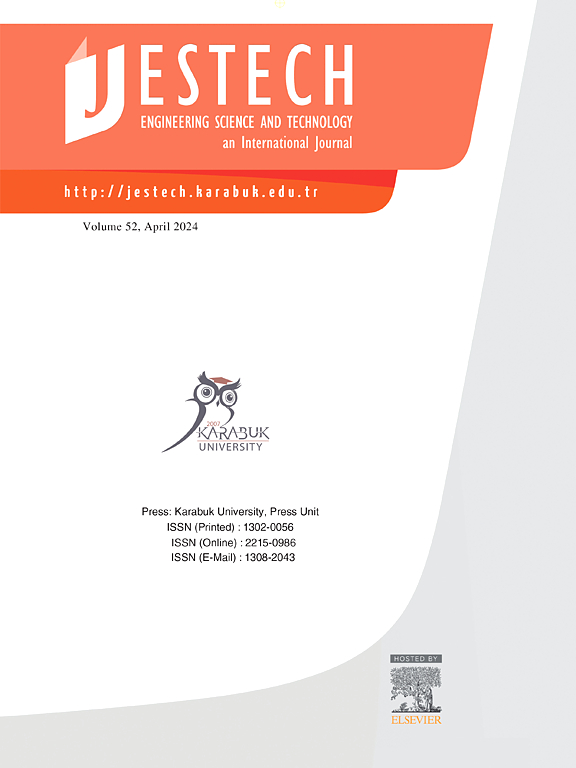应用预磁选技术解决磨矿分级密度效应,提高深层多金属磁铁矿的铁铜分离效果
IF 5.1
2区 工程技术
Q1 ENGINEERING, MULTIDISCIPLINARY
Engineering Science and Technology-An International Journal-Jestech
Pub Date : 2024-11-21
DOI:10.1016/j.jestch.2024.101912
引用次数: 0
摘要
本研究调查了安徽一种多金属磁铁矿在磨矿和分级过程中面临的挑战,特别是分级效率低、过磨严重和金属回收率降低等问题。通过分析矿石的矿物学特性,特别是矿物成分、互生关系、互生粒度和解离度,重点是磁铁矿、黄铜矿、钴矿物和贵金属矿物,该研究旨在找出造成这些问题的根本原因。随后进行了单因素实验,以评估磁场强度和研磨参数对磁铁矿和黄铜矿富集的影响。在最佳处理条件下,磁化电流为 0.25 A,磨矿细度为 65%,通过 200 目筛,在混合粗浮选过程中使用黄原酸丁酯作为捕收剂,铜回收率达到 89.54%。在这些发现的基础上,研究进一步讨论了各种工艺流程优化对磨矿、分级操作和目标矿物回收的影响。此外,研究还评估了不同选矿方法在实际应用中的优缺点,并最终提出了适合中深层矿床的选矿流程。本文章由计算机程序翻译,如有差异,请以英文原文为准。

Application of pre-magnetic separation to address grinding classification density effects and enhance iron-copper separation in deep polymetallic magnetite ores
This study investigates the challenges faced in the grinding and classification process of a polymetallic magnetite ore from Anhui, particularly focusing on low classification efficiency, significant over-grinding, and decreased metal recovery rates. By analyzing the mineralogical properties of the ore, specifically mineral composition, intergrowth relationships, intergrowth particle size, and liberation degree, with an emphasis on magnetite, chalcopyrite, cobalt minerals, and precious metal minerals, this research aims to identify the underlying causes of these issues. Subsequent single-factor experiments were conducted to assess the effects of magnetic field strength and grinding parameters on the enrichment of magnetite and chalcopyrite. Under optimal processing conditions, with a magnetizing current of 0.25 A and a grinding fineness of 65% passing through a 200-mesh sieve, the application of butyl xanthate as a collector during mixed rough flotation achieved a copper recovery rate of 89.54%. Building on these findings, the study further discusses the impact of various process flow optimizations on grinding, classification operations, and the recovery of target minerals. Additionally, it evaluates the advantages and disadvantages of different processing methods in practical applications and ultimately proposes a suitable mineral processing flow for intermediate to deep ore deposits.
求助全文
通过发布文献求助,成功后即可免费获取论文全文。
去求助
来源期刊

Engineering Science and Technology-An International Journal-Jestech
Materials Science-Electronic, Optical and Magnetic Materials
CiteScore
11.20
自引率
3.50%
发文量
153
审稿时长
22 days
期刊介绍:
Engineering Science and Technology, an International Journal (JESTECH) (formerly Technology), a peer-reviewed quarterly engineering journal, publishes both theoretical and experimental high quality papers of permanent interest, not previously published in journals, in the field of engineering and applied science which aims to promote the theory and practice of technology and engineering. In addition to peer-reviewed original research papers, the Editorial Board welcomes original research reports, state-of-the-art reviews and communications in the broadly defined field of engineering science and technology.
The scope of JESTECH includes a wide spectrum of subjects including:
-Electrical/Electronics and Computer Engineering (Biomedical Engineering and Instrumentation; Coding, Cryptography, and Information Protection; Communications, Networks, Mobile Computing and Distributed Systems; Compilers and Operating Systems; Computer Architecture, Parallel Processing, and Dependability; Computer Vision and Robotics; Control Theory; Electromagnetic Waves, Microwave Techniques and Antennas; Embedded Systems; Integrated Circuits, VLSI Design, Testing, and CAD; Microelectromechanical Systems; Microelectronics, and Electronic Devices and Circuits; Power, Energy and Energy Conversion Systems; Signal, Image, and Speech Processing)
-Mechanical and Civil Engineering (Automotive Technologies; Biomechanics; Construction Materials; Design and Manufacturing; Dynamics and Control; Energy Generation, Utilization, Conversion, and Storage; Fluid Mechanics and Hydraulics; Heat and Mass Transfer; Micro-Nano Sciences; Renewable and Sustainable Energy Technologies; Robotics and Mechatronics; Solid Mechanics and Structure; Thermal Sciences)
-Metallurgical and Materials Engineering (Advanced Materials Science; Biomaterials; Ceramic and Inorgnanic Materials; Electronic-Magnetic Materials; Energy and Environment; Materials Characterizastion; Metallurgy; Polymers and Nanocomposites)
 求助内容:
求助内容: 应助结果提醒方式:
应助结果提醒方式:


